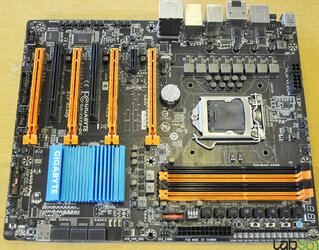- Joined
- Nov 12, 2002
- Location
- Rootstown, OH
The OC series are boards designed without some of the extras gamers and enthusiasts may look for, and instead added features desirable for Overclockers. This is a continuation of sorts from their X58-OC board reviewed here by Ross 2 years ago.
I haven't seen anyone talk in detail about the board yet, but from the pictures and just past knowledge, below is what I think is worth noting about it.
OC focused features:
- "OC Touch" - Physical, on the fly hardware buttons for multiplier and bclk while the system is running (techpowerup claimed hardware voltage control, but there are no physical buttons on the board to reflect this)
- Onboard power/reset/cmos clear buttons
- Tag, Turbo, and Gear buttons (turbo is likely an auto-oc feature, Gear allows you to change bclk resolution from .3 or 1 which affects how the bclk +/- buttons work, I don't know what Tag does)
- DIP switches to toggle PCIe slots on/off
- Port 80 display for POST codes/troubleshooting
- Voltage read points
- 3 DIPs for LN2 switch (enable/disable LN2 mode), backup BIOS, and unknown (possibly slow mode to drop the multi)
- 8 + 4 pin CPU power, 6 pin additional power connector for additional crossfire/sli PCIe power to ensure there isn't overdraw on the 24 pin ATX connection
- Minimal capacitors in socket area (ease subzero insulation)
- 9 fan headers on board (if I counted right)
In contrast to the X58-OC, there are a couple apparent changes:
- Some traditional cylindrical caps in the socket area, but fewer than you find on most motherboards. The X58-OC used POSCAPs across the board, which are flatter low profile alternatives, and make it easier to insulate
- Lack of on the fly PWM frequency DIP switches, as far as I can tell. The X58OC had DIP switches which allowed changing the CPU PWM frequency right on the motherboard. In my experience with extreme OC'ing this isn't necessary - you crank PWM frequency to the max, and that's where you leave it. I haven't found any advantages of reducing PWM frequency in subzero conditions (reducing it in ambient conditions will reduce heat output from the power section, which can be a good thing)
- DIMM sockets only have one retention latch on the top of the board, the other side just needs pressed in (with a long video card, this avoids potential clearance issues)
Possible prediction:
- This may not be a final design, and the cylindrical caps could be replaced by the flat caps used on the X58-OC
- Once they have the design on the heatsinks finished, this board is going to look hot (at least if you liked the look of the X58-OC, which I did)
The full article is available at the Romanian site Lab501, though they had to remove the pictures: http://lab501.ro/
Here is the picture that was posted there however, but keep in mind, this is not a final design - it doesn't have the PWM heatsink mounted, and the south bridge heatsink is not the final style:

I haven't seen anyone talk in detail about the board yet, but from the pictures and just past knowledge, below is what I think is worth noting about it.
OC focused features:
- "OC Touch" - Physical, on the fly hardware buttons for multiplier and bclk while the system is running (techpowerup claimed hardware voltage control, but there are no physical buttons on the board to reflect this)
- Onboard power/reset/cmos clear buttons
- Tag, Turbo, and Gear buttons (turbo is likely an auto-oc feature, Gear allows you to change bclk resolution from .3 or 1 which affects how the bclk +/- buttons work, I don't know what Tag does)
- DIP switches to toggle PCIe slots on/off
- Port 80 display for POST codes/troubleshooting
- Voltage read points
- 3 DIPs for LN2 switch (enable/disable LN2 mode), backup BIOS, and unknown (possibly slow mode to drop the multi)
- 8 + 4 pin CPU power, 6 pin additional power connector for additional crossfire/sli PCIe power to ensure there isn't overdraw on the 24 pin ATX connection
- Minimal capacitors in socket area (ease subzero insulation)
- 9 fan headers on board (if I counted right)
In contrast to the X58-OC, there are a couple apparent changes:
- Some traditional cylindrical caps in the socket area, but fewer than you find on most motherboards. The X58-OC used POSCAPs across the board, which are flatter low profile alternatives, and make it easier to insulate
- Lack of on the fly PWM frequency DIP switches, as far as I can tell. The X58OC had DIP switches which allowed changing the CPU PWM frequency right on the motherboard. In my experience with extreme OC'ing this isn't necessary - you crank PWM frequency to the max, and that's where you leave it. I haven't found any advantages of reducing PWM frequency in subzero conditions (reducing it in ambient conditions will reduce heat output from the power section, which can be a good thing)
- DIMM sockets only have one retention latch on the top of the board, the other side just needs pressed in (with a long video card, this avoids potential clearance issues)
Possible prediction:
- This may not be a final design, and the cylindrical caps could be replaced by the flat caps used on the X58-OC
- Once they have the design on the heatsinks finished, this board is going to look hot (at least if you liked the look of the X58-OC, which I did)
The full article is available at the Romanian site Lab501, though they had to remove the pictures: http://lab501.ro/
Here is the picture that was posted there however, but keep in mind, this is not a final design - it doesn't have the PWM heatsink mounted, and the south bridge heatsink is not the final style:

Last edited:

